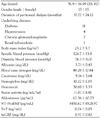1. Foley RN, Parfrey PS, Harnett JD, et al. Clinical and echocardiographic disease in patients starting end-stage renal disease therapy. Kidney Int. 1995. 47:186–192.
2. Silberberg JS, Barre PE, Prichard SS, Sniderman AD. Impact of left ventricular hypertrophy on survival in end-stage renal disease. Kidney Int. 1989. 36:286–290.
3. Wang AY, Wang M, Woo J, et al. Inflammation, residual kidney function, and cardiac hypertrophy are interrelated and combine adversely to enhance mortality and cardiovascular death risk of peritoneal dialysis patients. J Am Soc Nephrol. 2004. 15:2186–2194.
4. Diris JH, Hackeng CM, Kooman JP, Pinto YM, Hermens WT, van Dieijen-Visser MP. Impaired renal clearance explains elevated troponin T fragments in hemodialysis patients. Circulation. 2004. 109:23–25.
5. Deegan PB, Lafferty ME, Blumsohn A, Henderson IS, McGregor E. Prognostic value of troponin T in hemodialysis patients is in dependent of comorbidity. Kidney Int. 2001. 60:2399–2405.
6. deFilippi C, Wasserman S, Rosanio S, et al. Cardiac troponin T and C-reactive protein for predicting prognosis, coronary atherosclerosis, and cardiomyopathy in patients undergoing long-term hemodialysis. JAMA. 2003. 290:353–359.
7. Mallamaci F, Zoccali C, Parlongo S, et al. Diagnostic value of troponin T for alterations in left ventricular mass and function in dialysis patients. Kidney Int. 2002. 62:1884–1890.
8. Wang AY, Lam CW, Yu CM, et al. N-terminal pro-brain natriuretic peptide: an independent risk predictor of cardiovascular congestion, mortality, and adverse cardiovascular outcomes in chronic peritoneal dialysis patients. J Am Soc Nephrol. 2007. 18:321–330.
9. Rossi GP, Sacchetto A, Visentin P, et al. Changes in left ventricular anatomy and function in hypertension and primary aldosteronism. Hypertension. 1996. 27:1039–1045.
10. Denolle T, Chatellier G, Julien J, Battaglia C, Luo P, Plouin PF. Left ventricular mass and geometry before and after etiologic treatment in renovascular hypertension, aldosterone-producing adenoma, and pheochromocytoma. Am J Hypertens. 1993. 6:907–913.
11. Steigerwalt S, Zafar A, Mesiha N, Gardin J, Provenzano R. Role of aldosterone in left ventricular hypertrophy among African-American patients with end-stage renal disease on hemodialysis. Am J Nephrol. 2007. 27:159–163.
12. Sato A, Funder JW, Saruta T. Involvement of aldosterone in left ventricular hypertrophy of patients with end-stage renal failure treated with hemodialysis. Am J Hypertens. 1999. 12:867–873.
13. Devereux RB, de Simone G, Koren MJ, Roman MJ, Laragh JH. Left ventricular mass as a predictor of development of hypertension. Am J Hypertens. 1991. 4:603S–607S.
14. Savage DD, Garrison RJ, Kannel WB, et al. The spectrum of left ventricular hypertrophy in a general population sample: the framingham study. Circulation. 1987. 75:I26–I33.
15. Koren MJ, Devereux RB, Casale PN, Savage DD, Laragh JH. Relation of left ventricular mass and geometry to morbidity and mortality in uncomplicated essential hypertension. Ann Intern Med. 1991. 114:345–352.
16. Lang RM, Bierig M, Devereux RB, et al. Recommendations for chamber quantification. Eur J Echocardiogr. 2006. 7:79–108.
17. Delles C, Schmidt BM, Muller HJ, Oehmer S, Klingbeil AU, Schmieder RE. Functional relevance of aldosterone for the determination of left ventricular mass. Am J Cardiol. 2003. 91:297–301.
18. Song JS. Studies on plasma rennin and aldosterone in essential hypertension. Korean Circ J. 1974. 4:1–24.
19. Ratge D, Augustin R, Wisser H. Catecholamines, renin, aldosterone and arterial pressure in patients on chronic hemodialysis treatment. Int J Artif Organs. 1983. 6:255–260.
20. Hong ZR, Gil HW, Yang JO, Lee EY, Ahn JO, Hong SY. Associations between sympathetic activity, plasma concentrations of renin, aldosterone, and parathyroid hormone, and the degree of intractability of blood pressure control in hemodialysis patients. J Korean Med Sci. 2007. 22:604–610.
21. Malmqvist K, Ohman K, Lind L, Nystrom F, Kahan T. Relationships between left ventricular mass and the renin-angiotensin system, catecholamines, insulin and leptin. J Intern Med. 2002. 252:430–439.
22. Suh SY, Park CG, Chwe UR, et al. Plasma renin activity and clinical implication in Korean hypertensive patients. Korean Circ J. 2005. 35:658–664.
23. Roman MJ, Pickering TG, Schwartz JE, Pini R, Devereux RB. Relation of arterial structure and function to left ventricular geometric patterns in hypertensive adults. J Am Coll Cardiol. 1996. 28:751–756.
24. London GM, Guerin AP, Marchais SJ, et al. Cardiac and arterial interactions in end-stage renal disease. Kidney Int. 1996. 50:600–608.
25. Verdecchia P, Schillaci G, Borgioni C, et al. Adverse prognostic significance of concentric remodeling of the left ventricle in hypertensive patients with normal left ventricular mass. J Am Coll Cardiol. 1995. 25:871–878.
26. Choong CY, Herrmann HC, Weyman AE, Fifer MA. Preload dependence of doppler-derived indexes of left ventricular diastolic function in humans. J Am Coll Cardiol. 1987. 10:800–808.
27. Tsang TS, Barnes ME, Gersh BJ, Bailey KR, Seward JB. Left atrial volume as a morphophysiologic expression of left ventricular diastolic dysfunction and relation to cardiovascular risk burden. Am J Cardiol. 2002. 90:1284–1289.
28. Cho IJ, Pyun WB, Shin GJ. The influence of the left ventricular geometry on the left atrial size and left ventricular filling pressure in hypertensive patients, as assessed by echocardiography. Korean Circ J. 2009. 39:145–150.







 PDF
PDF ePub
ePub Citation
Citation Print
Print



 XML Download
XML Download